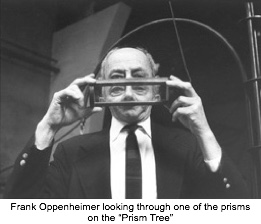Museums, Teaching and Learning | |||||
Frank Oppenheimer, Exploratorium Paper Prepared for the AAAS Meeting, Toronto, 1981 | |||||
For the people who have learned how to use them, most museums, certainly most major museums, have always been centers in the way that they have provided a great variety of patterns that people use for either teaching or learning. But somehow, until about 15 years ago, the potential of museums as adjunctive resources to other forms of learning have been neglected in the popular mind and even in the image that museums have had of themselves. It is not completely clear to me how this neglect came about perhaps some of it had to do with the media that led many innovative people to devote their attention to film, radio and television. A large part of the neglect, I think, had to do with the extraordinary preoccupation of both school and college teaching faculty with the notion of certification. Educational opportunities which did not provide any way of certifying the students or of evaluating their performance were relegated to a different domain and were not considered part of the overall process of public education. This preoccupation with certification has been, in fact, a very deadly one. It has produced generations of teachers who teach what they are supposed to teach rather than what they know and want to teach. Even university faculties sit around and talk about "what-should-the-students-know" rather than what it is that each of them would like to tell the students. In the lower levels of schooling, the preoccupation with certification has done even more damage. In any event, since museums do not certify, and the watching of television shows is not graded, or going to libraries cannot be supervised, all of these adjunctive resources for public education have been neglected. Concomitant with this neglect, schools have become more and more disappointing. They have taken on, and jealously guarded, the total job of education while having at the same time had to cope with |  | ||||
an ever more complicated society and an-increasingly mobile population. They have unfortunately failed abysmally. So museums, whether they are called a center or an exploratorium or a museum, must be perceived in a broader light; It is therefore fitting that we are talking about their role. Museums serve as centers in many different ways. They have their permanent exhibit collections and changing special ones. In addition, most of them produce written materials that include not only the labels which accompany the exhibits but also many other documents. At the Exploratorium, we have produced essays about the ideas related to our props as well as catalogues, books and magazines. Museums also create many visuals, including posters, reproductions, postcards, films and television programs. Almost every museum conducts classes and encourages classes that are taught by non-staff people but which are held in the museum. In addition, they arrange public lectures and provide tours, explainers, demonstrators and docents. They hold concerts, dance performances, panel discussions and sponsor conferences and | |||||